![]()
![]()
![]()
Use LEFT and RIGHT arrow keys to navigate between flashcards;
Use UP and DOWN arrow keys to flip the card;
H to show hint;
A reads text to speech;
29 Cards in this Set
- Front
- Back
|
How does alveolar ventilation rate change as alveolar partial pressure of CO2 changes? |
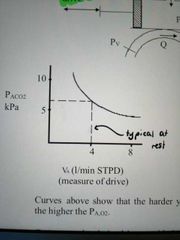
As ventilation rate increases, PACO2 decreases |
|
|
How does alveolar partial pressure of oxygen change as ventilation rate changes? |
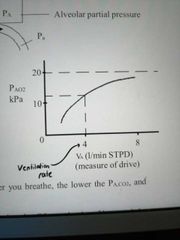
As ventilation rate increases, PAO2 increases |
|
|
What is the formula for CO2 production rate? |
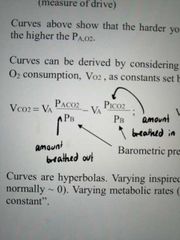
|
|
|
What is the formula for oxygen consumption? |
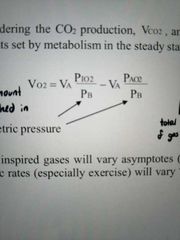
|
|
|
What 3 things need to be considered when determining ventilation rate? |
- we want to breathe enough to saturate our Hb as much as possible - we don't want to breathe any more than necessary as it is a waste of effort - we need to tightly control CO2 because it can drastically change pH |
|
|
What is the pH of normal blood? |
7.35-7.45 |
|
|
What are the two types of chemoreceptors? |
Central and peripheral |
|
|
Where are the central chemoreceptors located and how are they arranged? |
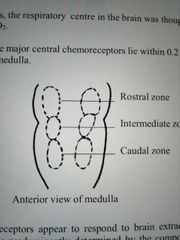
Within the anterior medulla: there are 3 sets, a rostral, intermediate, and caudal zone |
|
|
What do central chemoreceptors respond to? |
CSF pH Blood PCO2 |
|
|
Why do central chemoreceptors not respond to blood pH? |
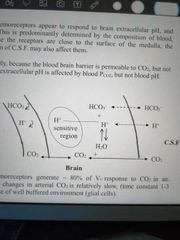
Because hydrogen ions cannot pass through the blood brain barrier. Instead, they use CO2 as a marker because it can pass through, be converted to HCO3- and H+, and alert the chemoreceptor |
|
|
How long does it take the central chemoreceptors to respond to changes in PCO2? Why? |
1-3 mins. This is quite long because the chemoreceptors are surrounded by supporting glial cells which provide a good buffer against acidification |
|
|
What are the two types of peripheral chemoreceptors? What effects do they each have? |
Carotid bodies - Respiratory effects Aortic bodies - vascular effects |
|
|
Where are carotid bodies found? |
Near the baroreceptors, close to the junction of the internal and external carotid arteries |
|
|
How are carotid bodies innervated? |
By the sinus nerve, a branch of the glossopharyngeal nerve |
|
|
What are the main stimuli for carotid bodies? |
Decreases in pO2, or a rise in pH or pCO2 |
|
|
Describe the structure of a carotid body |
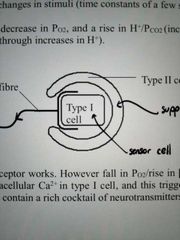
Type one cells produce the response and pass the signal onto the nerve fibre |
|
|
What does 'interactive' hypoxia and hypercapnia mean? |
It means they both act together and must be both be present in order to produce a meaningful response from the carotid bodies |
|
|
Draw graphs to show the interactive nature of hypoxia and hypercapnia. Describe the graphs. |
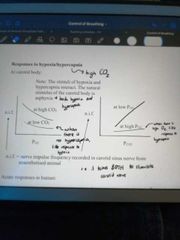
On the left, a decreasing pO2 (hypoxia) only results in increased firing of the carotid body nerve fibre at high CO2 levels (hypercapnia). Similarly, on the right, increasing pCO2 (hypercapnia) only increases nerve impulse frequency if accompanied by hypoxia |
|
|
Draw a graph showing the changes in ventilation rate associated with sustained isocapnic hypoxia |

|
|
|
How did we discover where the respiratory centres are located? |
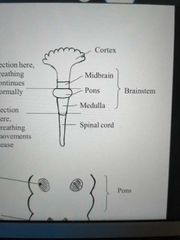
By sectioning parts of the brainstem. Sectioning above the pons doesn't alter breathing, but sectioning below it does. This indicates breathing centres are located in the pons/medulla |
|
|
What 3 structures make up the brainstem? |
Midbrain Pons Medulla |
|
|
What are the 3 respiratory centres within the midbrain and how are they arranged? |
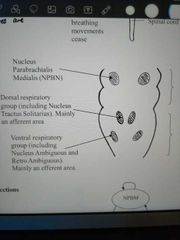
Nucleus Parabrachialis Medialis Dorsal respiratory group (afferent) Ventral respiratory group (efferent) |
|
|
What are the 3 types of receptors in the lungs? |
Pulmonary stretch receptors Irritant receptors Juxtacapillary receptors |
|
|
Describe pulmonary stretch receptors |
- receptors between smooth muscle cells in large airways - innervated by large myelinated fibres of the vagus - respond to slowly to stretch - cause inhibition of inspiration, and also bronchodilation |
|
|
Describe Irritant receptors |
- Receptors between epithelial cells in large airways - innervated by small myelinated fibres of the vagus - respond rapidly to stretch and irritants such as smoke or histamine - cause cough, bronchoconstriction and tachypnoea |
|
|
Describe Juxtacapillary receptors? |
- 'J receptors' - receptors by alveoli and capillaries - unmyelinated C fibres of the vagus - stimulated by oedema in interstitium of lung - cause rapid, shallow breathing |
|
|
What are the consequences of removal of the carotid bodies? |
A slightly higher PACO2 (+0.5kPa) No sensitivity to hypoxia |
|
|
What are the consequences of having no functioning chemoreceptors? |
Wildly varying PAO2 values (2.5-7.5kPa) Adequate breathing while awake but need to be ventilated while asleep |
|
|
What are the consequences of losing your lung receptors, eg during a transplant? |
None :) |

